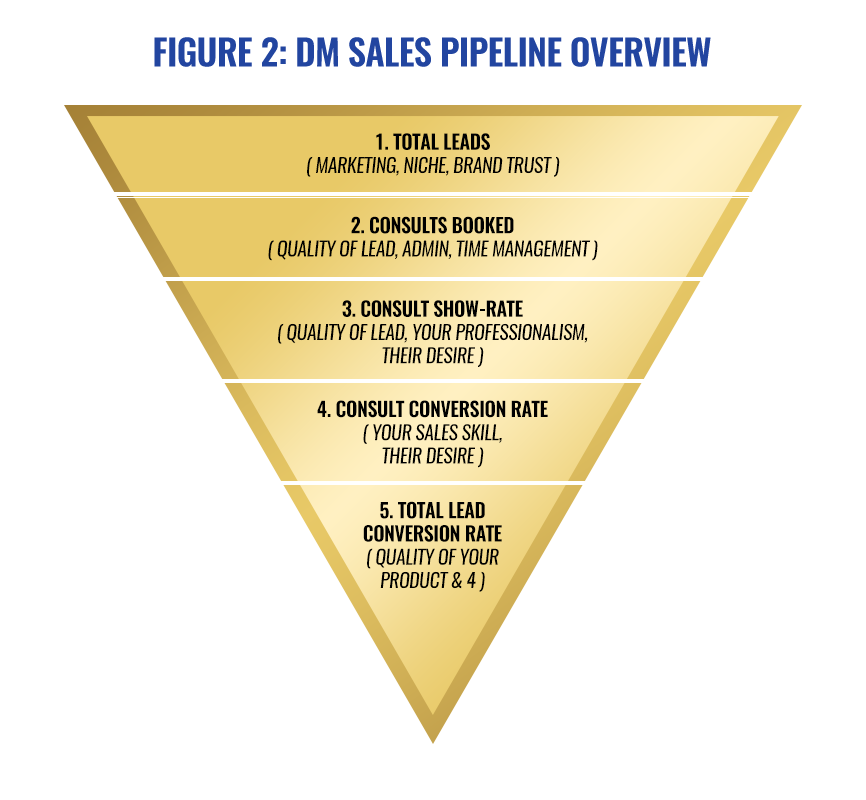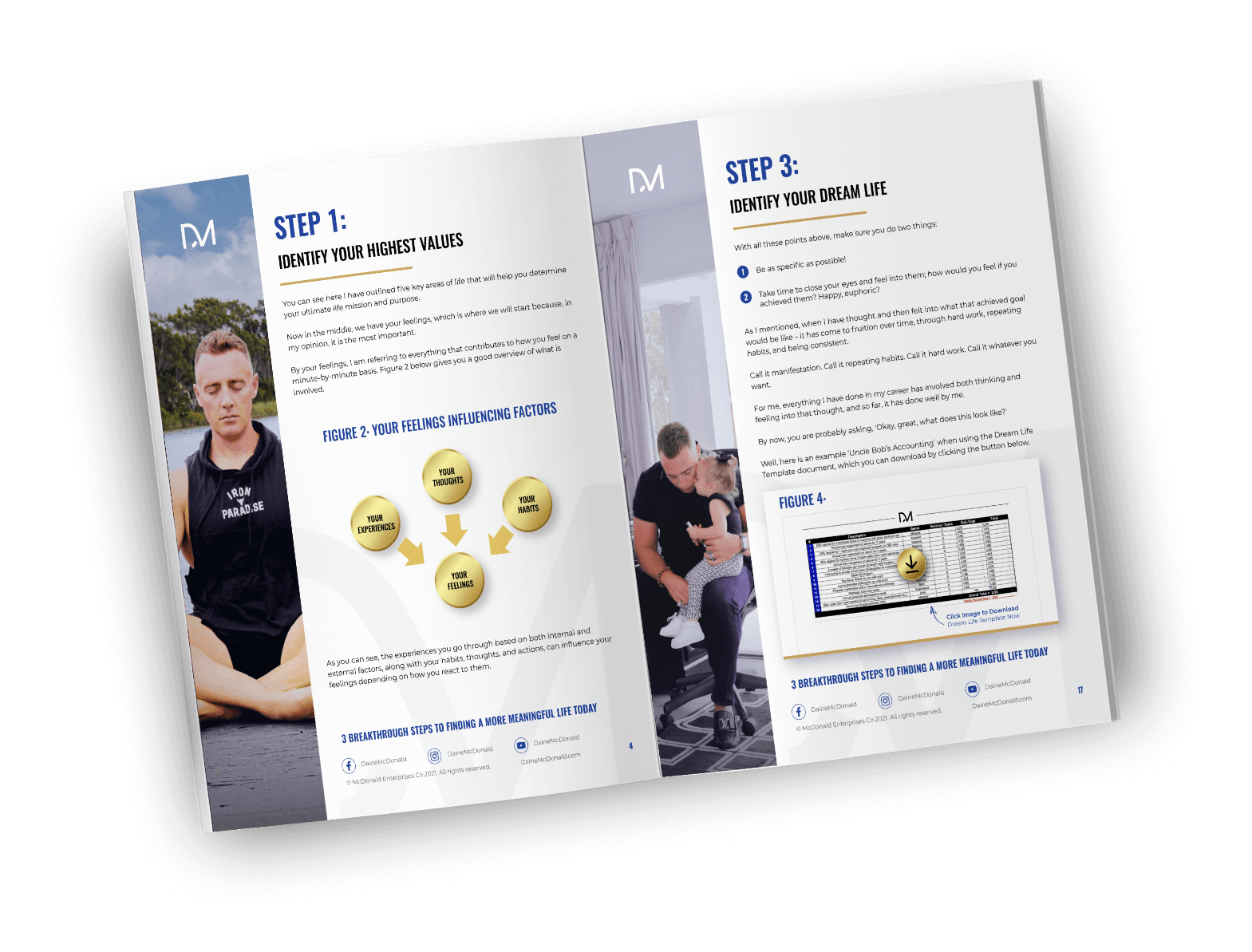
Revenue vs Income and What it Means for You
This one might sound simple, but the reality is it’s one of the most overlooked components of any business. Many entrepreneurs assume that just because

In business, if you can’t sell your product or service – you are dead in the water.
It is all well and good if you can generate leads, but ultimately, your ability to sell a solution to the customers need and desire is what is going to have the most significant impact on your overall success.
Now that we have clarified that, we need to know what metrics you need to measure to make you and your teams more efficient and productive.
Not having sales targets is like trying to drive from point A to point B without knowing the exact directions, and without direction in business, there is no clarity on where you are going.
Figure 1 outlines what I believe is crucial when it comes to sales mastery.

Being aware of the intricacies of step 4 is what separates good from world-class sales consultants.
You need to track your results when it comes to sales, whether you are doing them yourself or within your sales team, and there are plenty of CRM platforms out there that you can use to enable this to be done automatically for you.
As you can see in figure 2, I have provided an overview of what key metrics are crucial for sales as your customers come through your own unique sales pipeline.

Now let’s break it down in more detail!
In short, it is the total volume of leads that are coming into your business. This will be a combination of highly motivated people ready to start, along with those who are window shopping or somewhere in between.
Now a lead is someone who:
With all leads, I like to break them up into hot and warm categories.
A hot lead is ready to buy from you, whereas a warm lead is still in the consideration stage.
Why do I break them up?
Because a hot lead is generally further down the sales, funnel to conversion, and they just need that nudge from you during the sales consult to convert.
A warm lead is further up the sales funnel, so in a discovery stage where they know, they need something like what you are offering but have not yet built up the confidence or commitment levels to act.
With warm leads, these people are often window-shopping, so the way you approach the sales consult all though the same from a process standpoint will require a much more in-depth needs analysis than a hot lead.
Ultimately with this metric, if you are not generating enough leads, it could mean you are not positioning your product to the right niche or in the right way to your target niche.
It could also mean you have not yet built up enough brand awareness in the marketplace and that your relevant marketing strategies are not effective.
This metric is the total volume of consults you have booked from the total leads you have acquired. Just because you get a lead, it doesn’t mean you can book them in for a consult.
This could be for various reasons; they were window shopping, got busy, lost your details etc., however, you can expect to not book in every lead you receive as you scale.
A simple process you can use to optimise this metric is what I have always trained my sales teams – what I call the ‘Trifecta’. This is where you:
With point 4, note that sometimes people are just busy.
However, after 5 days, you are not successful; you can be 90% certain the lead is ‘dead’ and was just either window shopping or is fearful of change.
In short, you are contacting them through the three primary mediums, ensuring that there can be no excuse from their side that you ‘never contacted them’.
Why is this metric so important?
Because it gives you a % of total leads to consults booked. An example would be:
So, 40% of your total leads, on average, are booked into consults.
If you are struggling with this metric, it could mean you are struggling to book consults due to poor time management, admin processes within your business etc.
Remember, a rule of thumb here that you must adhere to for your own sake is any inbound lead enquiries should be contacted on the same day at a minimum.
As a business scales, show rates tend to drop off, along with consults booked.
The consult show rate is the number of consults that have been booked but, for whatever reason, did not show up at the allocated time.
e.g., you might have a target of needing to convert 2 clients per week, but you know you only currently convert 25% of your consults. That would mean:
As you can see, vital information you must know!
If you are struggling with the show rate, it could mean that your customer is window shopping and not committed.
It could also mean that you contacted them days after you got their lead, and they said yes to you on the phone being friendly but then ghosted you on the day hence why same-day responses are imperative!
This is a measurement of the total amount of consults you have ‘won’. So, it is only based on a lead to consult conversion ratio, nothing more.
This is easy to track, simply put:
This is a great metric to track as you increase your sales mastery at it shows how you are improving.
Conversely, if you have a team, you can set this as a key performance indicator and overall efficacy assessment of your sales consultants’ proficiency.
Ultimately though, section 4 will relate to your ability to solve the customer’s problem and provide them with a solution, i.e., your product or service.
This is where technical ability and experience around sales is crucial!
This is the summary of a total lead to conversion ratio, so it does not consider things like no-shows or those you were never able to get through to.
So, an example might be:
As you can see, this is another essential sale metric to be aware of!
Finally, with 5, low results here can relate to the actual quality of your product and the solution you are providing, along with the same reasons as number 4 re; your skill set in sales and level of subject matter expertise.
Here are your three key takeaways from this article:
Ps. Want to stay up to date with more content like this from me? Subscribe to my channels now below:

This one might sound simple, but the reality is it’s one of the most overlooked components of any business. Many entrepreneurs assume that just because

Nothing determines business success (or failure) more than workplace culture… We know that not only does good sleep, healthy eating and regular exercise build a

As a society, we have learned to look at the concept of success through a very narrow lens. We have been taught that having a

In this comprehensive free eBook, you’ll learn simple yet effective changes you can make in your life right now to attract more purpose, clarity and abundance within your family, fitness, and finances!
